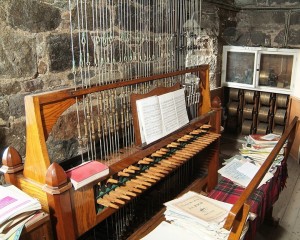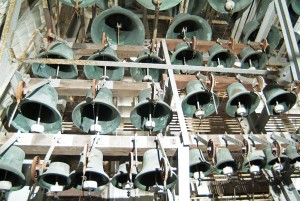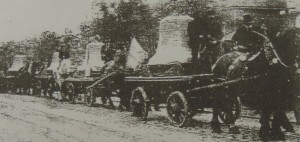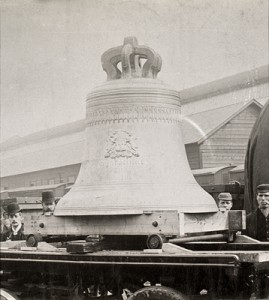Following the destruction of the bells in the fire of 1874 and the rebuilding of the spire (see Blog on 13th March 2016), there was common agreement that new bells should be installed. A century and a half ago it was common practice for the bells to be ‘shared’ between church and council, the former using them on Sundays whilst their weekday use was primarily civic. Unfortunately in this case there was disagreement between the Kirk and the civic authorities on who should control the peal and its hours of ringing. In 1881, after 6 years of argument, the Kirk Session relinquished control to the Town Council. During this time without bells, and until new bells were in place, the authorities of St Mary’s Roman Catholic Cathedral in Huntly Street, which had a chime of nine bells, ‘very courteously rang their bells on Sundays to suit other church-going folk than their own’.

After considerable debate, it was decided that a carillon would be installed in the Kirk rather than a peal of bells for change ringing. In a carillon, the bells are fixed in position and it is the clapper which is moved to make the sound. The clappers are connected to a keyboard using wires and metal levers. The keyboard looks a bit like a large piano, but rather than keys it has pegs which are struck or stroked by the hand. Each key is connected to the appropriate bell. Most carillons also have a pedal board similar to that on an organ and also connected to the appropriate bell clapper. Thus several bells may be played at the same time, and in quick succession, which allows quite complex music to be played by one person. The photograph shows the carillon ‘keys’ in the present carillon at the Kirk of St Nicholas.

With the decision taken to have a carillon, it was agreed to order 36 bells from Severin van Aershodt of Louvain in Belgium. An indication of popularity of the move can be gauged from the fact that no less than 30 of the bells were donated by local churches, public bodies and individuals. The remaining six were gifted by the Council. A thirty-seventh bell was later given by Alexander Lyon Jr when he became Convener of the Bells Committee.


When complete, the bells were shipped to Leith and brought to Aberdeen by rail. On the afternoon of 12th May 1887 they were paraded on horse-drawn lorries on a circuitous route on the streets of Aberdeen eventually arriving at the Kirk for mounting in the spire (see photographs). The inauguration and dedication ceremony took place on 18th June 1887, during the Jubilee celebrations of Queen Victoria. The largest bell was duly named ‘Victoria’ and was used for striking the hours. However, it rapidly became obvious that there was a big problem because the sound produced by the bells was not good, some reports suggest barely audible. Reports suggest that there were three problems: the design of the mechanical action was poor; the bells were not tuned accurately; the metal used for the bells had insufficient tin, which produced a very poor tone. Thus after the excitement, there was disappointment, resulting in the bells hardly being used, apart from playing hymn and psalm tunes on the lower pitched bells before church on Sunday mornings.
We will bring the story up to date in the next Blog on the bells in a few weeks.